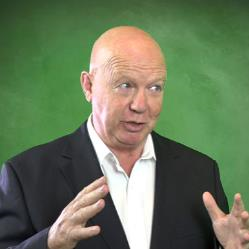 "Get the basics right and the rest will follow" - Interview by John Smibert
"Get the basics right and the rest will follow" - Interview by John Smibert
The biggest challenge most salespeople have is finding good prospects - filling their sales pipeline with quality sales opportunities.
So I thought I would invite the prospecting master himself, Steve Hall, to do a series of interviews with me to help you learn or refresh your prospecting knowledge.
 In the first I asked him to outline what he saw as the basics of prospecting. The first point he made is that "there's a lot of high-level tools out there that people are using, there's a lot of fancy theories which are really great, but if you don't know the basics" none of those tools or theories will help.
In the first I asked him to outline what he saw as the basics of prospecting. The first point he made is that "there's a lot of high-level tools out there that people are using, there's a lot of fancy theories which are really great, but if you don't know the basics" none of those tools or theories will help.
During this discussion Steve focuses on five basic aspects of prospecting:
- Which companies are you targeting specifically the organisations names.
- Which people are you targeting, roles and names.
- What do they care about,
- How do you get the message to them,
- What is the specific message, depending upon what you're trying to achieve.
In this discussion Steve describes each of these - and in future discussions he will drill down into more detail.
I commend this 10 minute video to you - alternatively you can read the transcript below.
**********
Steve is a thought leader in sales. He's an executive sales coach, a keynote speaker, a storyteller and he likes to play Devil's Advocate to help dispel myths around selling and marketing. He helps his clients to sell more effectively to "C" level executives and to develop compelling messages and business stories..
See more of the 'TALKING SALES' series here
Interview:
John: Hey B2B sellers, welcome back again to this next Talking Sales series with Steve Hall - welcome back, Steve!
Steve: Good day, John!
John: Last time we talked about the fact we're going to do a series of interviews with Steve around prospecting, around lead generation, getting your ideal customer out there to talk with you. I'm looking forward to doing that, Steve, but I thought first off we might just get down to the basics. What we'll probably hear here are things that people are familiar with, but let's refresh everybody's mind on the basics of prospecting.
 Steve: That's a great idea, John. I think there's a lot of high-level tools out there that people are using, there's a lot of fancy theories which are really great, but if you don't know the basics... Have you been to the Picasso Museum in Paris?
Steve: That's a great idea, John. I think there's a lot of high-level tools out there that people are using, there's a lot of fancy theories which are really great, but if you don't know the basics... Have you been to the Picasso Museum in Paris?
John: No, I haven't - tell me about it!
Steve: Well, basically Picasso left thousands of paintings to the French state, because he had a heap of tax and that's the way he paid it when he died, so there's all these pictures and you can see some of his really crazy stuff, with women cut open and strange nudes and stuff you would never recognise, and he was a master at inventing new genres of art. But his early stuff, he was just a brilliant, brilliant draftsman, because until you know the rules you can't break them. So if you don't follow these basics, then any of the fancy stuff is not going to work.
John: So you're going to go through the very basics which some of us need reminding of, me particularly.
Steve: Let's face it, there are always new salespeople coming along that don't know this stuff; I've come across some very experienced salespeople that might know it but they don't do it. So, some of the very basic stuff is, first of all, targeting. Who are the companies, what is your territory, what are the companies you are targeting, who needs what you have to sell? And I'm looking at targeting from a perspective of the size, the industry, the geography, the different characteristics that make up your prospecting base, your target market. But more than that, who specifically are the companies, what are the list of your top 50, 100, 300 companies that you're targeting?
 John: And part of that is just identifying who your ideal client is, and going out and saying, "These are my ideal clients." Is that right?
John: And part of that is just identifying who your ideal client is, and going out and saying, "These are my ideal clients." Is that right?
Steve: That's right. And look, you think that is bleeding obvious, to quote John Cleese, but three years ago I worked with one of the three largest software companies in the world on helping them get some meetings, and they've decided they wanted to do some targeted marketing to a niche audience of financial services in Australia. I say, "Great. Okay, give me your list," and they say, "We don't have a list," and I said, "What, you mean you don't know which companies you want to target?" and they said, "No, but we'll get a list from Hoover's," and I say, "Well, Hoover's is the American company that knows all about America but not that much about Australia," and they said, "Oh..." They just literally didn't know which companies they wanted to target, so I ended up getting a list for them. There's not that many banks, insurance companies, credit unions, health funds in Australia, it was easy to get, but they didn't have that.
The next question I asked them, which comes to the next thing, is who do you want to target? Which particular individuals in those companies?"
John: The title of a person, like CEO and CFO or even a digital marketing person or whatever. You need to know who the target is inside an organisation.
Steve: Exactly. And don't forget, different people have different titles; you might say, "I want the Head of Sales and Marketing," but banks for instance probably don't have that title, so you've got to look at the individuals that you want. If you're going to target specific people... Because at the end of the day all sales comes down to one individual talking to one or more individuals, so you need to know who they are.
John: Absolutely - I understand that.
Steve: That's really basic, but if you want to use digital marketing or a telephone call or LinkedIn or whatever it may be that you're going to use to get to a person, the first thing you need to know is who that person is. It sounds obvious, I know, but you'd be amazed.
John: Okay. [laughs] Next.
Steve: The next question is what do they care about? Just suppose you're selling to a large bank. What the CEO cares about, what the CIO cares about and what the Head of Sales and Marketing care about are going to be different variations of the same thing.
John: You know, Steve, there's a lot of argument and discussion out there about cold calling is dead, or a lot of people are saying cold calling is living forever... All of this is still important if you're going to do a cold call. It's ridiculous doing a cold call if you haven't identified the target organisation, the individual and what that individual cares about.
Steve: That's right. If you're the CEO, you're going to care about the reputation of the company, you're going to care about profitability, and you're going to care about long-term sustainability perhaps.
John: And probably in this day of cyber security, security and so on.
Steve: Well, certainly minimising risk of all kinds is a key thing for the CEO, whereas the Head of Sales and Marketing is possibly less concerned about risk and more concerned about new customers. So you've got to craft your message depending upon who you're talking to and what you're trying to achieve.
John: Okay, good point. The next?
Steve: The next question is if you're going to go to someone for the first time, they're not an existing customer, what are you trying to achieve? Obviously in the long term you want to sell them some stuff, but what are you trying to achieve in that first communication, whether it would be an email, whether it would be going through LinkedIn, whether it would be a telephone call, whether you're going to send them a parcel? Whatever it might be, what are you trying to achieve?
John: Okay - that's really important. I want to go back one step. You said, "What do they care about?" Obviously in between there therefore you need to craft a message.
Steve: Yes, you need to craft a message, but your message is going to depend upon what you're trying to achieve.
John: Okay, so you're saying that you identify what they care about, and before you craft your message you make sure you understand what you're trying to achieve, and you put those two together and you craft a message out of that.
Steve: Exactly. And not all the time, but most of the time you're trying to achieve a meeting where you have enough time to understand what they really care about and to get your value proposition across in terms of what they care about. That's challenging to do in a one-page email or a 30-second telephone call of a letter, because we jump to conclusions. In the recent presidential debates Hillary Clinton said, "Words matter." Words do matter, words matter a lot, and because there's so much stuff going on we all use shortcuts, so a particular word will immediately... If you speak to someone and use a particular word, they will immediately think of it in relation to what they know.
John: Based on their context.
Steve: Based on their context. I had a client recently who helped retailers minimise losses, and one of their challenges was that immediately when they talked to a retailer the word "loss" conjures up a particular set of things that they know about.
John: And that can vary from one person to another person or another person in that retailing organisation.
Steve: In that particular case retailers tend to think of "loss" as a stock shrinkage, and therefore their automatic reaction was, "Oh, we've got those under control because we do something about it," but in fact what they were talking about was much broader than that. It was about theft, it was about shrinkage, it was about lack of training, it was about incorrect pricing; there's a whole heap of things that they covered under that great heading of loss. They came to me to help them craft a message, and we had to craft a message that stopped people hearing it and jumping to the incorrect conclusion.
John: Great point, and I've seen that happen too often. We come into an organisation, "I am going to sell to you and craft my message around our unique value proposition," and I present it, and their reaction is totally different to what I expected, they're thinking about something totally different. So that's what you're talking about, get in the mind of the customer and make sure the words you use are expressed as a message that they understand in their context.
Steve: Yes. And when we're talking about crafting messages, you want to give them as little as possible in order to achieve your objective.
John: Yes. The last thing they're going to listen to is a lot of content on the telephone or in an email or whatever.
Steve: The more you tell them, the more chance there is of jumping to the incorrect conclusion, because you can never tell them enough to fully explain what you have.
John: Okay - great point. So, the message needs to be short, succinct, written from their point of view, from their context, so that they immediately, based on a very small number of words, jump to the right conclusion.
Steve: That's right. Let me give you an example, and I think I've used this before, but for one client we talked to retailers, we thought about what retailers cared about, which was in those days, and probably still is, was online competition, competition from Internet companies, and the message was very simple. "We want to talk to you for half an hour, about helping you compete better with online retailers." Didn't give them too much, didn't let them jump to conclusions, and told them what we wanted. Short, sharp, easy.
 John: And back then if they didn't have an online retailing capacity, immediately they might jump to conclusions.
John: And back then if they didn't have an online retailing capacity, immediately they might jump to conclusions.
Steve: Even if they did, they were still looking at ways to help with that.
John: Yes. So you make sure, based on I guess the research you did, that those words would draw up the right perception from the customer as to what you were talking about.
Steve: But not too much.
John: Right.
Steve: Because if you then say, "And the way we do this is through bla-bla-bla," then they think, "Oh, we've got one of those, we're already doing that," or whatever. What you want to do is you want to generate curiosity, you want to make them think "Maybe I should speak to these people, because they might just be able to help me."
John: Okay - I think that's great. Is that the last of them?
Steve: That's the last of them.
John: So, let's just summarise those, and we'll come back and talk about each of those in more detail in separate discussions.
Steve: Works for me!
John: Run through them quickly.
Steve: Which companies are you targeting specifically, names, which people are you targeting, roles and names, what do they care about, how do you get the message to them, which we didn't really cover but we will, and what is the specific message, depending upon what you're trying to achieve.
John: Okay - that sounds great. Steve, I really look forward to having you come back again in two or three weeks, and we'll cover each one of those one after the other over the next five months or so.
Steve: Look forward to it, John!
John: Thank you, Steve!
Steve: Take care!
****************
More interviews with Steve Hall:
*******************************

Your Invitation: I invite you to join the Sales Leader Forum group on LinkedIn where you can experience informative discussions with your peers and sales thought leaders on subjects like the one we have discussed here. I also invite you to subscribe to the
- Sales Leader Resource Centre here
- Sales Leader YouTube channel here (300+ sales leadership videos)
Please Share: If you valued this article, please share via your Twitter, LinkedIn, Google+ and Facebook social media platforms. I encourage you to join the conversation or ask questions. So feel free to add a comment on this post - I promise to respond. If inclined please follow my LinkedIn post page here.
Want to touch base? If you have questions please feel free to contact me - email: john.smibert(at)salesleaderforums.com, Phone: +61 404857893 or Skype: john.smibert